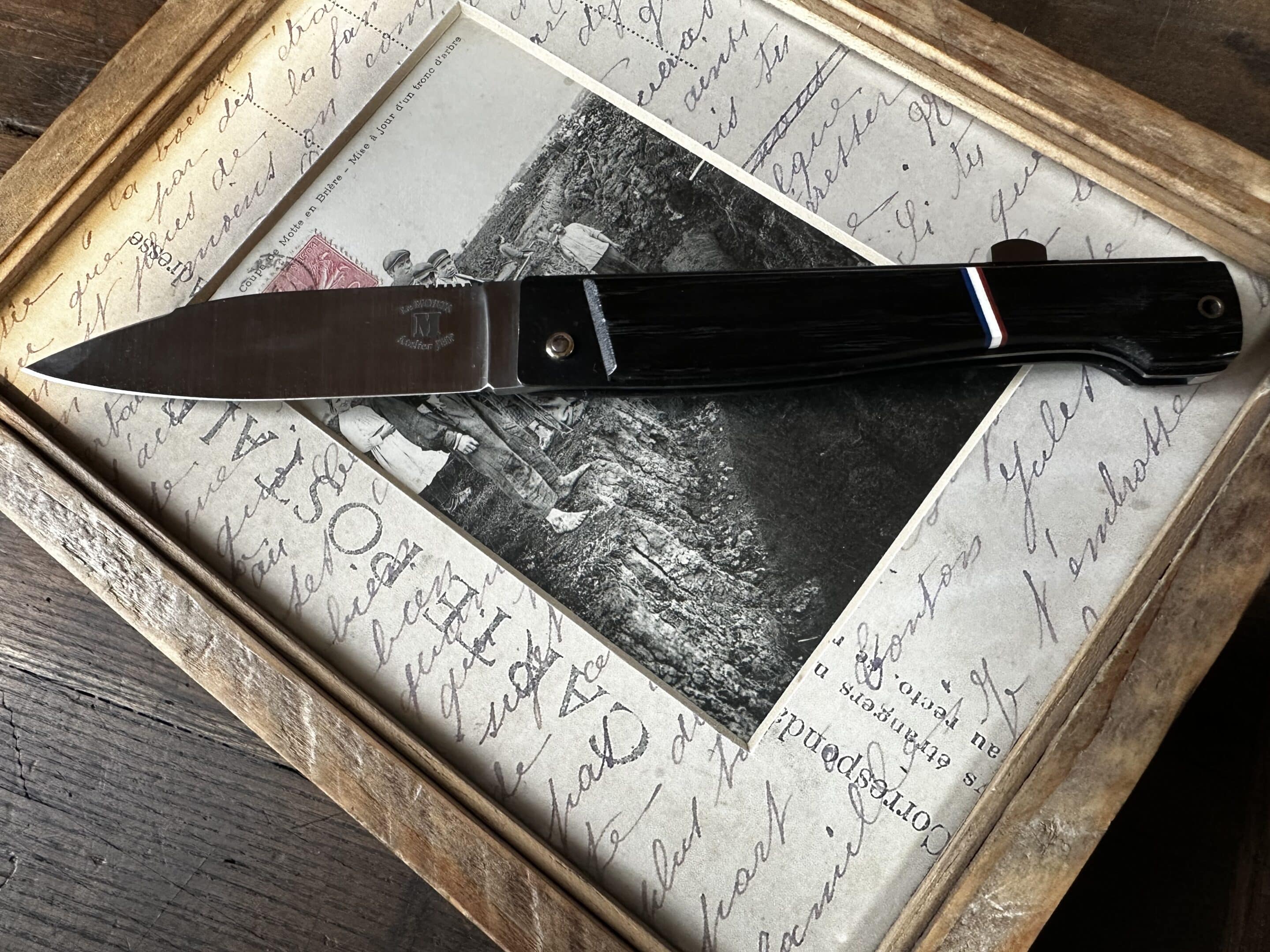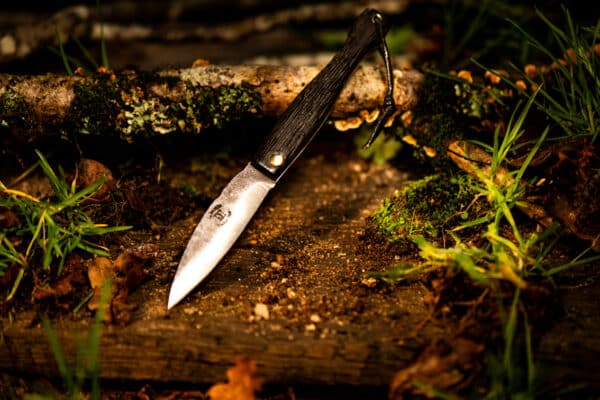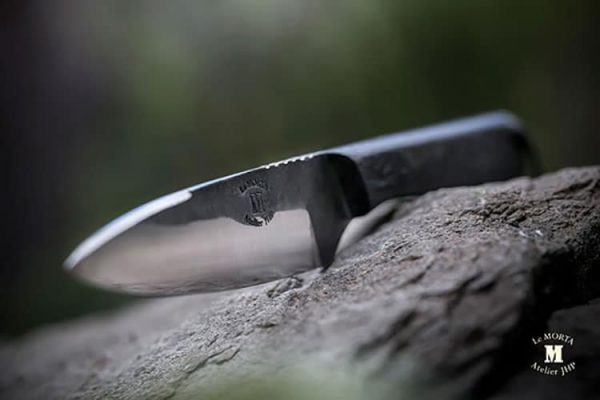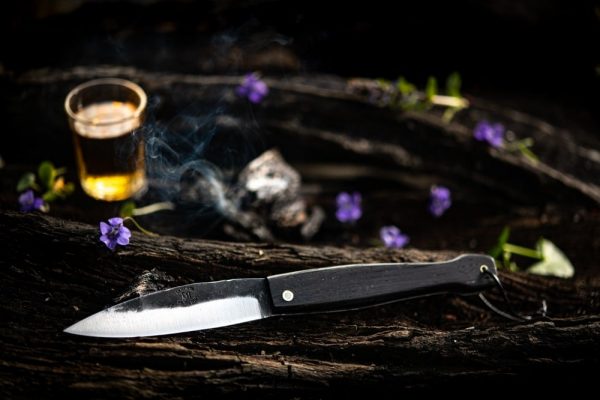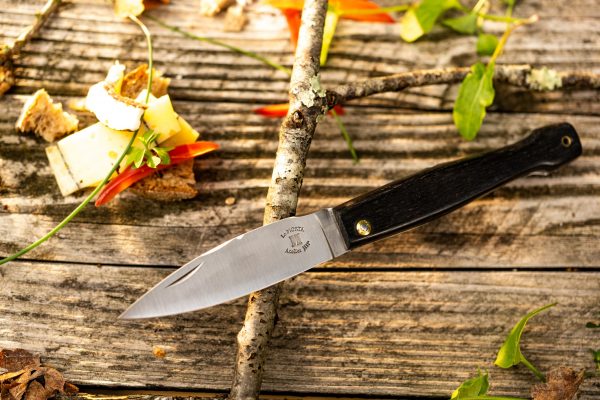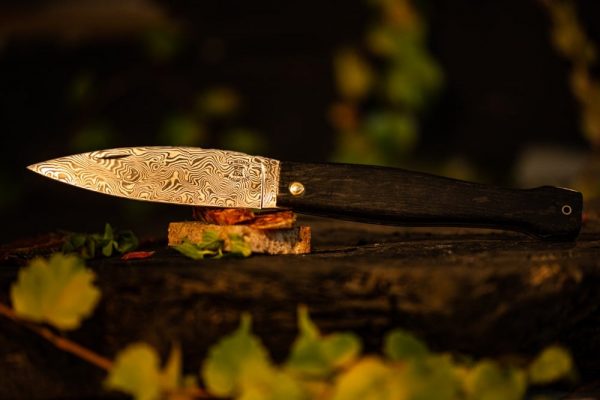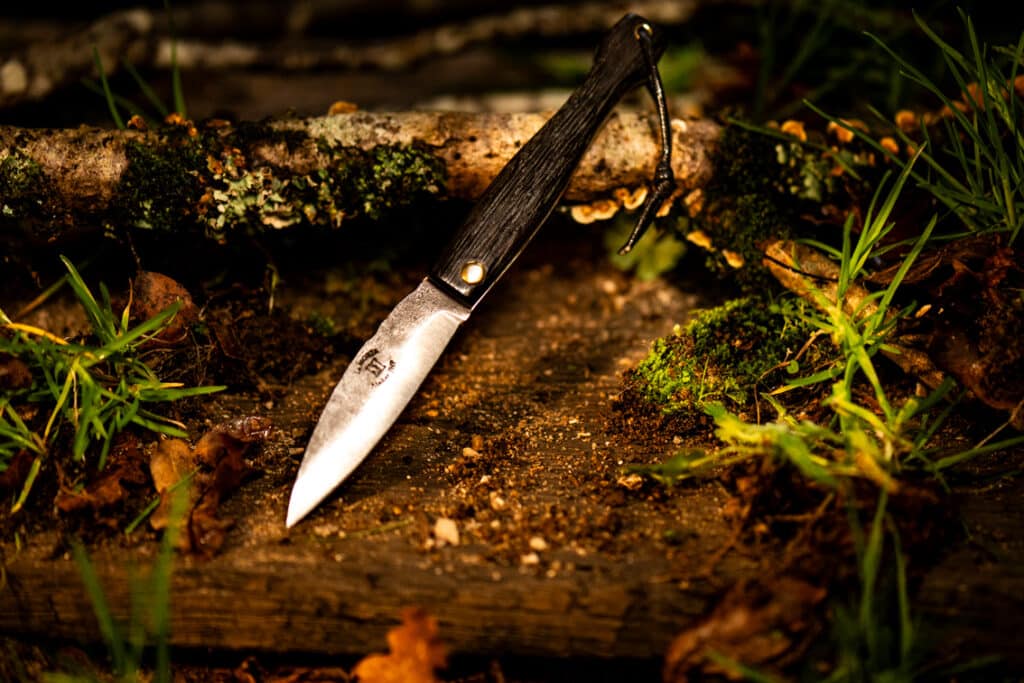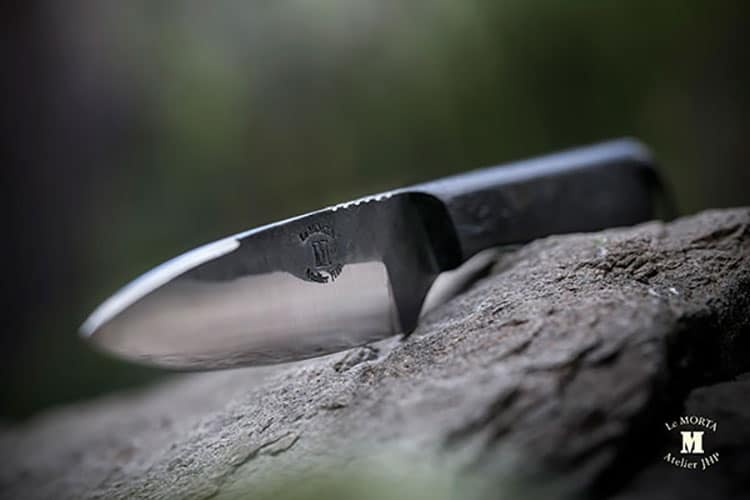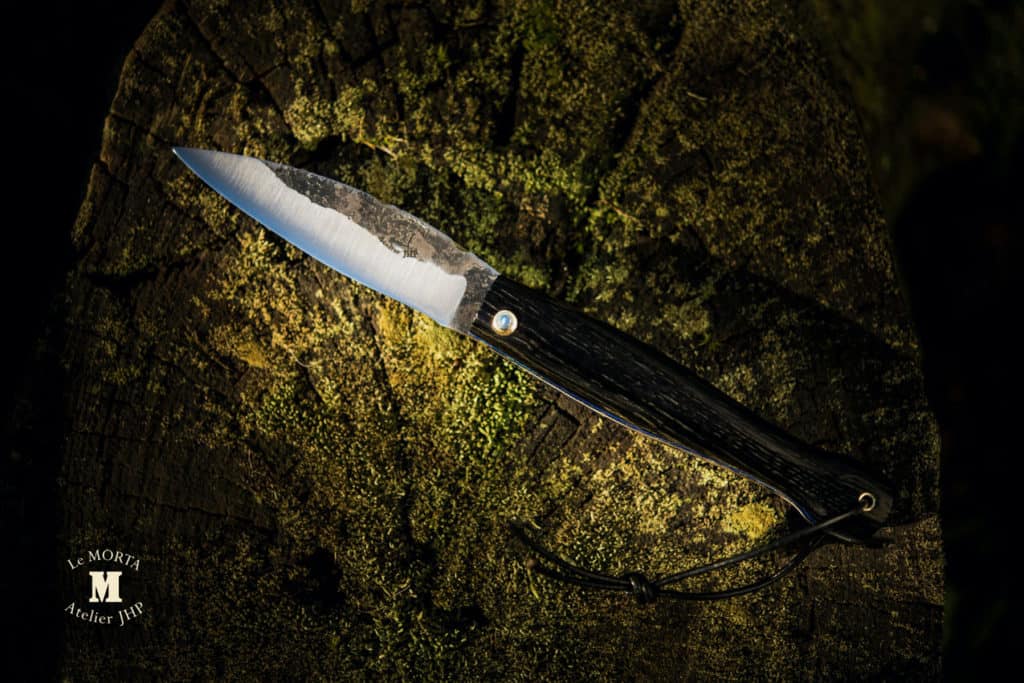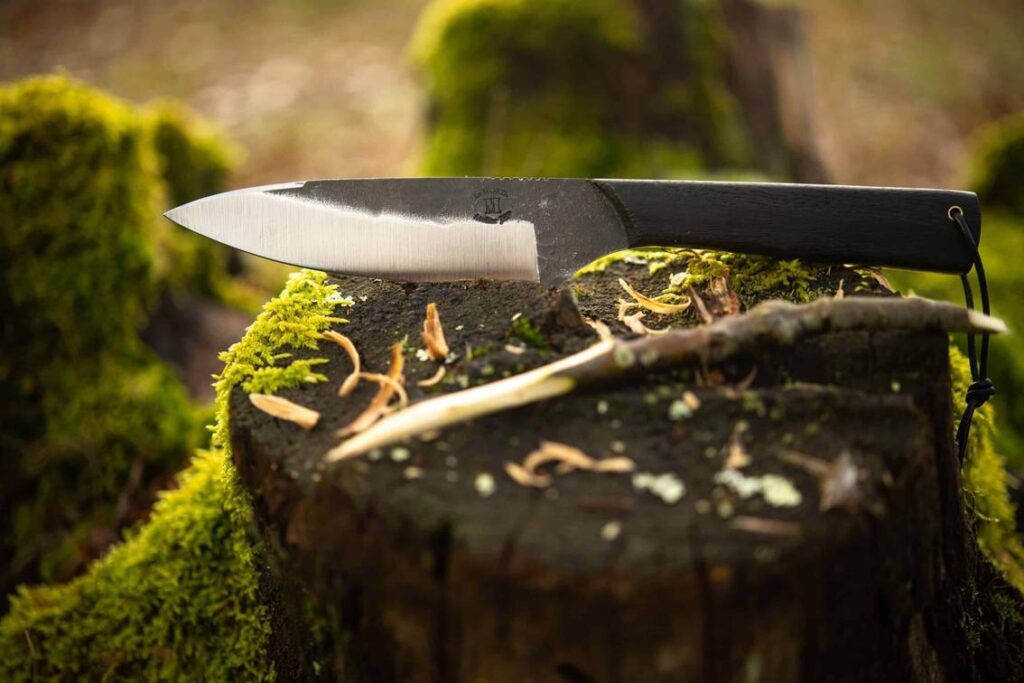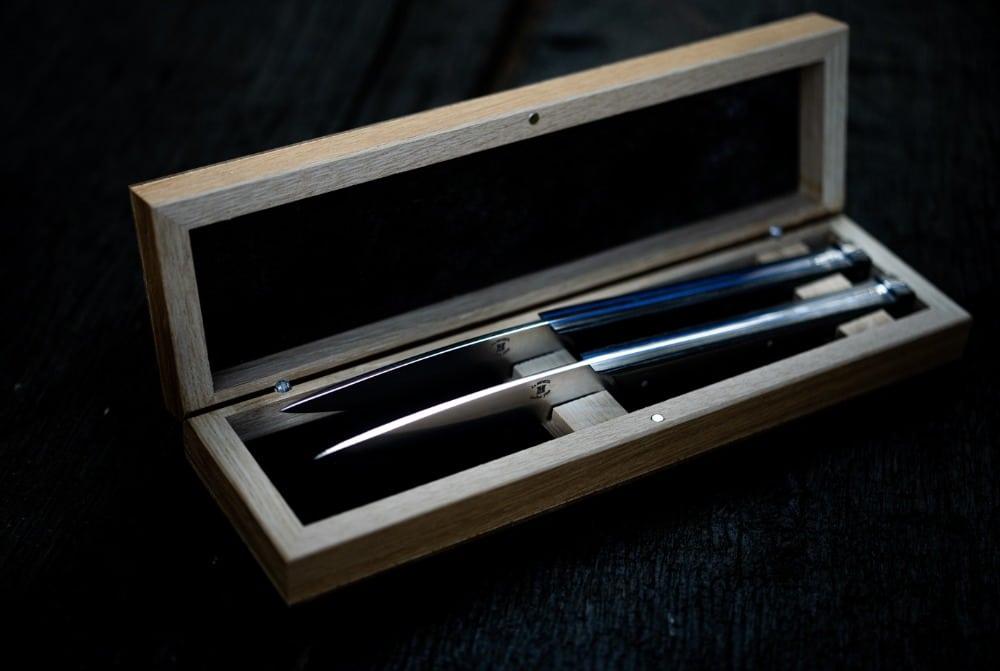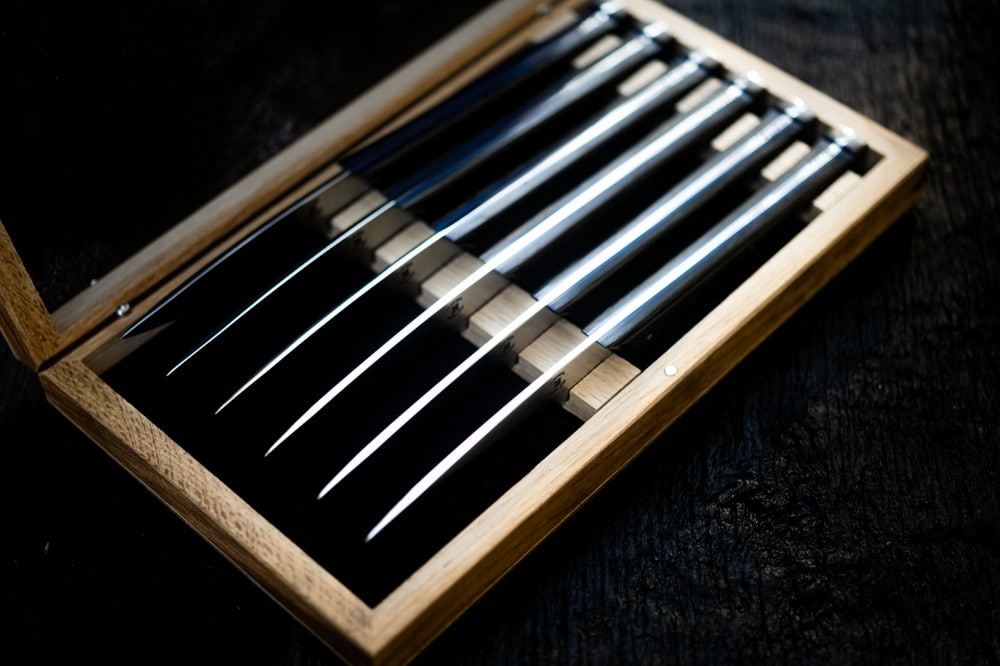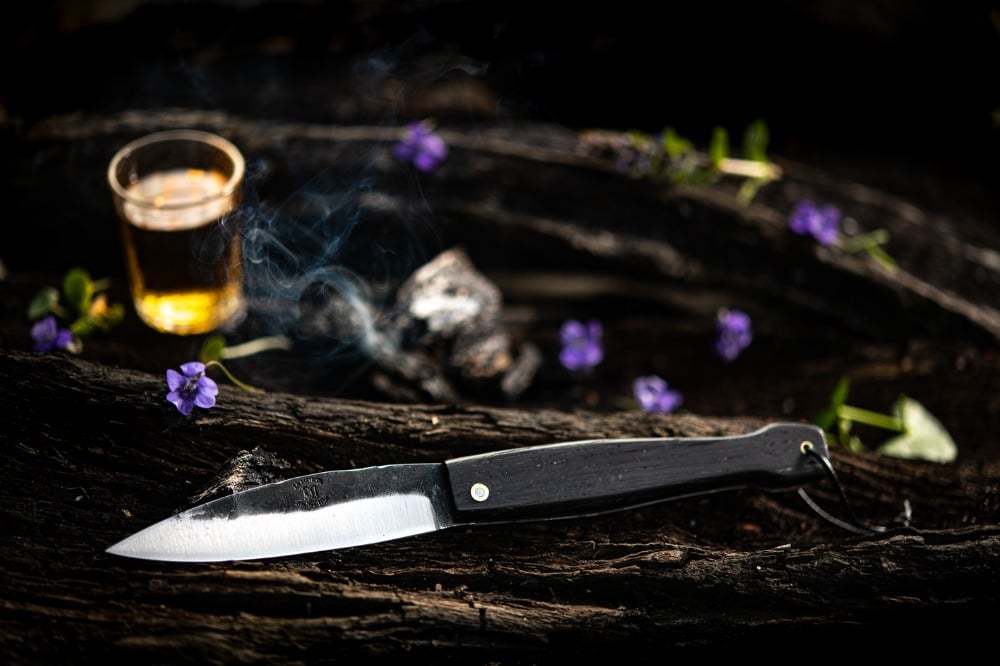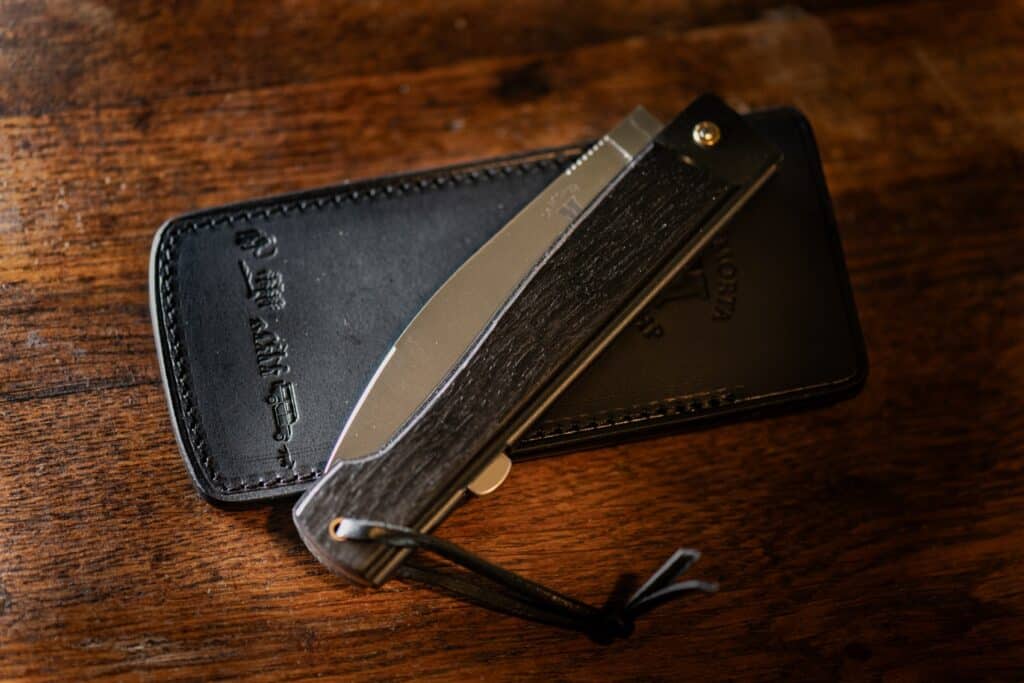The knife is one of the oldest objects created by humans. During prehistoric times, Neanderthals crafted cutting tools, while Homo sapiens made the first knives from bone or obsidian, initially simple and then evolving into more complex designs. Serving as a cutting instrument, a weapon for defense and hunting, the knife has been crucial for human survival. Through the Stone Age, the Age of Metals, Antiquity, and the Middle Ages, techniques continuously evolved, especially with the art of forging blades. Handles, too, were adorned according to the fashion and wealth of their owners. It was the Industrial Revolution, with the advent of machine tools and electricity, that transformed and mechanized the world of cutlery. It wasn’t until the 21st century that consumers began to seek out knives that reflected the heritage values and centuries-old craftsmanship of the cutler. We invite you on a journey through time with the knife as the hero of our story.
The stone age: The knife of Homo Habilis
The Paleolithic: The four needs for a knife
📆 Paleolithic: -2 million years to -10,000 years
Around 300,000 years ago, prehuman australopithecines utilized natural materials as they were: branches, pebbles, flints, bones, obsidian (volcanic rock), etc. Homo habilis began to adapt these materials for specific functions, creating tools for four fundamental needs:
- crushing,
- scraping,
- piercing,
- and cutting.
They quickly diversified the tools and accelerated the production of weapons.
In the Middle Paleolithic, Neanderthals gave way to Homo sapiens, who mastered fire and improved tool making. They produced the first single and then double-edged knives from bone or obsidian flakes.
The history of the knife (as we know it today) began in the Upper Paleolithic (-35,000 to -10,000). Humans refined and diversified their knife-making, notably as weapons. They used what could be considered a fixed blade for hunting animals and also for the first tribal wars.
Cro-Magnon man added an artistic dimension to blades, initially through figurative art, with knife drawings found on cave walls and burial sites. Quickly, they also used it for clothing decoration. At this time, bone and ivory were predominantly used.
Mesolithic: Flint
📆 Mesolithic: -10,000 to -6,000
With climate warming leading to a semi-nomadic lifestyle, bows and arrows enabled hunting. Humans now mastered flake techniques, marking the era of flint knapping. Scrapers and blades were sharpened, but flint remained more effective, especially for deadly arrowheads for hunting deer, boars, and roe deer.
Polished stone, on the other hand, served both aesthetic and efficiency demands.
Neolithic: Polished stone
📆 Neolithic: -6,000 to -2,300
This period was pivotal, combining the reign of polished stone with the beginnings of metallurgy, introduced from the East.
The diversification continued. Humans settled down, hunted, domesticated animals, and replaced foraging with crop cultivation. Bovids provided bones that supplanted wood in cutlery manufacturing.
😉 Did you know?
🔪 The first copper working site appeared in Turkey around -7,000.
🔪 Iran made the first alloys around -5,000.
🔪 The Chaldeans (a nomadic people of what is now Iraq) invented the tempering of ferrous metals around -3,000.
🔪 The Egyptians added a tang to serve as a handle and to attach the knife.
🔪 The oldest known elaborated knife had a 22.5 cm flint blade and a hippopotamus ivory handle. It was discovered in Gebel El Arak, Egypt, dating back to -3,300.
The age of metals: Protohistoric knives
Europe, especially the south of France (with its forests and rivers), played a major role in this era of metallurgy and forging. The first commercial exchanges appeared. Armed maritime expeditions brought back tin and zinc for the production of the first bronzes.
Age of copper: The arrival of alloys
📆 Copper age: -2,500 to -2,000
Stone usage was predominant, but the work with alloys, hammering, and shaping of sheets began. Metals were sought after for their malleability to manufacture knives. Although copper was used more for kitchen utensils, copper daggers from this era have been found in Isère.
The first tangs appeared, facilitating the use of wood for handles fixed with liquefied tendons.
Age of bronze: Primarily functional tools
📆 Bronze Age: -2,300 to -800
During the Bronze Age, tools were designed for their effectiveness: hard and sharpenable. Forging faced competition from casting, which allowed for more diverse shapes and sizes. However, forging remained the predominant technique. The profession of blacksmith emerged to meet the demand for weapons driven by territorial wars.
The Romans created the first friction-folding knives, a multifunctional tool. Later, they invented the ferrule. Vikings used a clasp model with a latch.
Age of iron: welding
📆 Iron Age: -800 to -50
This era is named for the invention of forge welding followed by tempering. The latter technique involves heating a metal that has already been hardened to a moderate temperature to make it more pliable.
🔪 23 tempered and tempered knives dating from -1,050 were discovered in Cyprus.
🔪 The first major ironworking site was at Hallstatt in Austria (around -750).
Antiquity: The art of forging and Gallo-Roman knives
📆 Antiquity: -50 to 500 AD
Inspired by Vulcan, the god of iron, Gallo-Roman blacksmiths were respected experts for their craftsmanship. Cutlery became a craft and trade activity. Roman troops invaded Gaul, which fell under Caesar’s laws. Antiquity was marked by military conquests and battles. The knife, dagger, sword, and dirk were primary weapons.
Cutlers of the time manufactured blades for military use, but also for cultural purposes. Knives were now protected in their sheaths.
Included were:
- Swords (the spatha);
- Hunting knives (the machaera);
- Daggers (the semispatha);
- Scalaprum for cutting reeds for writing;
- Sutorius (razors);
- Sica for gladiators (curved blade);
- Secespita for slaughtering the sacrificial animal, excoriatus for skinning, dunaculum for disemboweling, and dolabra for detaching limbs;
- Kitchen knives (culter coquinarius);
- Utility knives (cultellus).
Roman knives served for daily uses, not just military purposes.
Middle ages and renaissance: The blacksmith becomes a cutler
📆 Middle Ages: 500 to 1,500 AD
📆 Renaissance: 1,400 to 1,600 AD
The transition from the Middle Ages to the Renaissance occurred around the discovery of America. The Renaissance bridged the Middle Ages and the modern era, with the contemporary period beginning with the French Revolution.
Conflicts prompt weapon making
The 5th and 6th centuries saw numerous invasions by the Franks, Visigoths, Lombards, Alamanni, and Burgundians. These warriors equipped themselves with heavy swords similar to the Roman model. They also used broad and short knives, like the scramasaxe, for better maneuverability and resistance to twisting.
🗡 The Franks decorated their weapons with cloisonné enamel, as evidenced by knives found in Manneville or Neufchâtel.
🗡 The Visigoths created a belt pouch to carry two knives, to which they added scissors or bone combs.
🗡 The Lombards carried a sword and a cutlass.
🗡 The Burgundians extended the use of the pouch to domestic knives, such as kitchen knives. They invented long knives with hollow square socket handles.
In the Middle Ages, numerous conflicts significantly propelled the development of forging, especially for weapons and tools. The blacksmith’s trade confirmed its recognized expertise.
A first industrial revolution occurred with the arrival of machinery, notably the waterwheel-powered hammer mill. This machine used a series of two to three hammers striking anvils, powered by water. It allowed for the drawing of metal bars, plating, and forging.
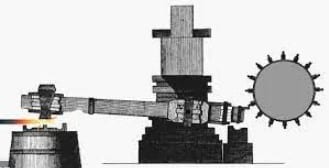
Photo credit: Wikipedia
Knives born in the Middle Ages
Between the years 500 and 1,500 AD, lifestyle habits led to the creation of new blades. Illumination and the insertion of precious stones responded to a desire for aesthetics that reached its peak in the 14th century. Luxury cutlery would not be recognized until the 18th century.
The cutler profession organized into guilds.
It was during this period that:
- Hand guards were created to protect the hands;
- Side notches and hooks were introduced;
- Sharpening steels were invented.
Blacksmiths became true specialists in culinary trades, manufacturing:
- Knives reserved for the table. At this time, there were neither forks nor plates, and meat was served on a slice of bread;
- Slicing knives (with broad blades);
- The parepain (for cutting the famous slice-plate);
- The small coustel (for boning, removing nerves);
- The taille-bois (similar to a machete);
- The oyster knife;
- The chopping knife (curved blade);
- The rocking mincer (or two-handed chopper);
- The canivet for trimming goose feathers for writing.
Christianity also influenced cutlery fashions, as evidenced by:
- Lenten knives (ebony handle);
- Easter knives (ivory handle);
- Pentecost knives (checkered handle).
At the end of the 15th century, the fixed blade knife began to share its place with folding models. The appearance of pockets in clothing contributed to this evolution.
Let yourself be tempted by our knives… ✨
-

Mini solid morta as forged
210,00 € This product has multiple variants. The options may be chosen on the product page -

Compact fixed knife as forged
180,00 € This product has multiple variants. The options may be chosen on the product page -

XL Solid Morta as forged
325,00 € This product has multiple variants. The options may be chosen on the product page
😉 Did you know?
🔪 Women (including nuns) wore a small fixed-blade knife on their belt, held in place by a cord.
🔪In 1265, the Archbishop of Rouen forbade carved knives to the nuns of Montivilliers because of the sin of vanity.
🔪Philippe de Hardi in 1275 made the hallmark obligatory on all silver knives. Towns with a community of silversmiths create their own quality hallmarks.
🔪In 1260, Boileau, Prefect of Paris, separated the guild into two branches: cutlery makers (making the cutting object) and handle makers.
Industrial Revolution: Machine tools transform cutlery
New machining processes
Western Europe entered its proto-industrial era in the 17th century. However, it was the scientific and technical advances of the 19th century that launched the period known as the Industrial Revolution. Blast furnaces emerged in 1860. Cheap cast iron proliferated. Surface treatments (chroming, nickel plating, electroplating) protected steels.
Among the advancements were the mastery of hydraulic power, equipping cutlers with machines and speeding up production through:
- “Dog cages” or “man wheels,” mechanical drive mechanisms;
- Arm-driven hammer mills (for forging);
- Press-driven hammer mills (for stamping).
New steels were created:
- Carbon steel (obtained through carburization or melting), known as cutlery steel;
- Alloys: like tungsten for hardness or argenton (copper and zinc) for reduced oxidization.
All these new processes cut costs and production times. Craftsmanship is becoming industrialized. Look for the error 😉.
Cutlery innovations
Knives continued to meet increasingly specific needs (meat, fish, cheese, dessert knives).
Handles also evolved. Bovine horn replaced ivory (now reserved for luxury knives). Synthetic materials (parkesine, celluloid, galalith, bakelite) allowed for new, varied colors.
The folding knife became democratized. Useful and functional, it was no longer a luxury object.
The canivet was equipped with a triangular appendage for scraping errors and flattening paper.
🔪 1820: Introduction of the penknife in the sliding knife.
🔪 1827: Invention of the round, pivoting blade. The flared forging of the heel prevented the blade from touching the tablecloth. This technique was later replaced by the ferrule.
🔪 1830: Appearance of fly and tenon knives, Catalan knives, and the broken spring (today the pump spring).
🔪 1872: Invention of the sleeve ferrule.
New ranges of knives
Each profession called for a range of knives.
Medicine equipped itself with lancets and scalpels.
The authorization to carry rifles led to the creation of various hunting knives.
The Charretier (a multifunctional knife sometimes with two blades) met the versatile needs of peasants:
- Punch;
- Bloodletting (veterinary flame);
- Hoof pick for horses.
Gardeners used pruning and grafting knives for trees, called “jardinieres” if they contained several blades.
Knives were now categorized by region: Thiers, Normandy, Rouen, Nogent.
😉 Did you know?
Miniature knives were created. Miniatures, like gigantism in cutlery, often served to demonstrate artisans’ skill. Think of Nontron (housed in a walnut), charms, or fleas (made from a turtle shell).
France exported to Spain, Italy, South America, and Africa.
On the national territory, sales by stagecoach persisted, but stores appeared. “Clincailleries” offered ordinary knives as well as fine and luxury cutlery.
Some finely crafted figures
The 1855 World Fair counted:
- 1,000 master cutlers and foremen;
- 3,000 blacksmiths;
- 4,000 grinders and polishers;
- 2,000 filers and temperers;
- 100 setters, sharpeners, and rosette makers.
History of the knife: The 21st Century proclaims the knife an art object
The 20th century heralded the arrival of electricity. But the great post-1900 cutlery revolution remained stainless steel when, in 1913, Harry Brearley added 12% chromium to steel. After several tests, surgical steels (440C) remained the most used.
The influence of modern life on knife use
Urbanization and industrial jobs changed French habits. The ballpoint pen, for example, signaled the disappearance of the goose quill penknife.
Workers needed a pocket format: can opener or pocketknife. They wanted it lightweight, hence the decline in wooden handles and tool models. Paid holidays sparked desires for camping, general leisure activities which led to the modernization of existing systems: safety catch or liner lock. This marked the rise of the tool-knife, the corkscrew knife, or the box cutter.
In 1921, Karl Elsener founded his Swiss knife brand: Victorinox.
The 20th century was also the century of two world wars. The armaments sector ordered soldiers’ knives: Model 1916 dagger, bayonet, skeleton knife, machete, commando knife, etc.
And for the handles?
With the abandonment of animal traction, horn became rarer, and like tortoiseshell or ivory, it gave way to cheaper and non-fossil synthetic materials. The 1960s brought resin, and the 1970s introduced ceramic. The advent of the dishwasher strengthened the appeal of handles made from synthetic materials.
The knife as an identity marker
Now, the knife takes on a symbolic dimension and carries a message.
🔪 Commemorative knives: war, exhibitions, personalities, etc.
🔪 Professional knives: even EDF (Electricité de France) and SNCF (French National Railway Company) have their logos on knives.
🔪 Identity knives: political parties, Freemasons, associations, etc.
🔪 Promotional knives (advertising objects).
🔪 Designer knives (like Nontron).
Contemporary French Cutlery
It wasn’t until the second half of the 20th century that the French began to rediscover their roots and the traditional regional crafts. Today, a knife is not just a tool; it reflects heritage, passed down from generation to generation. People appreciate it for its noble materials and the quality of French craftsmanship.
Currently, the French knife industry comprises 624 manufacturers, including 130 of significant size. The metallurgy observatory (in partnership with the French Cutlery Federation) notes the French people’s attachment to pocket knives, viewed as:
🔪 A vintage, local “art object”
A beautiful item suitable as a gift.
Let yourself be tempted by our pocket knives… ✨
-

Solid Morta
140,00 € This product has multiple variants. The options may be chosen on the product page -

Mini solid morta as forged
210,00 € This product has multiple variants. The options may be chosen on the product page -

XL Solid Morta Damascus
525,00 € This product has multiple variants. The options may be chosen on the product page
The knife market in France, according to the same observatory, appreciates:
🔪 The option for personalization, appealing to the consumer for being unique and tailored to their tastes.
🔪 A local, made-in-France offer, for consumers sensitive to history;
A positioning in the mid and high-end market.
All our knives are made in France? Oops, that’s all we offer: all our knives, then 😊🇫🇷!
Through the centuries, the knife has always followed the evolution of human needs. An everyday tool, a work instrument, a weapon for defense or hunting, it wears as many faces as it serves functions: fixed knife, kitchen knife, folding knife, there’s a knife for everyone. After numerous modernizations, today’s knife aims to reflect a cultural and historical heritage. Luckily, we only manufacture models that make sense. The Morta handle reminds us of our origins, the quality of our knives, the French know-how. What else? Beauty? This way, friends.


